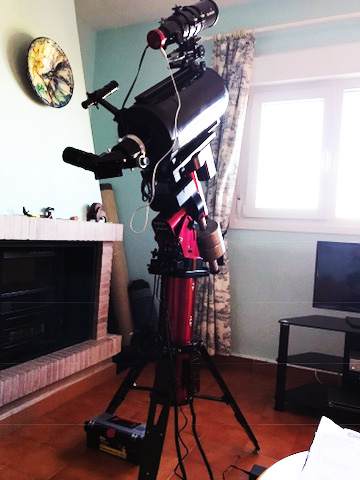Day 47 Clocks forward 1 hour in Europe - Pallas and Pomona
 Sunday, March 30, 2014 at 6:02AM
Sunday, March 30, 2014 at 6:02AM The clocks have "Sprung forward" by an hour today in Spain and in the UK so that Spain is now 2 hours ahead of Greenwich Mean Time or Universal Time (U.T.). I checked my software to make sure it had all adjusted automatically as I have settings for Leyland Observatory, Cabrera Observatory, Siding Spring in New South Wales, New Mexico Skies , and various other remote telescope locations in the United States. I need to make sure that I know the local time whichever telescope I am using particularly to make advance automated bookings as these are obviously based on local time.
A couple of years ago I gave a presentation on remote imaging to Bolton Astronomical Society. I have now converted this to pdf format from PowerPoint so it can be downloaded. Click on the image to get the pdf file. It may take a while to download.
A clear night tonight and I am trying out the CGEM mount with the SkyX software for the first time. I aligned the CGEM manually from the handset outside and aligned on 2 stars - certainly not as accurate as the 6 star alignment. SkyX connected without a problem having set the USB port to port 8. I slewed the telescope to the first target by entering "2 Pallas" into the search box and clicking the slew button. Of course I was faced with a number of dots in the 38' field one of which could be the minor planet. I saved the image and solved the plate. In fact I had missed the field containing Pallas completely. By using the slow motion controls within SkyX I managed to get an image which solved to correspond to the position of Pallas. Pallas was extremely bright so I centred it in the on screen cross hairs and performed a "synch". I should have carried out a 6 star alignment! With the solved image in which Pallas was indicated by its SkyX label I took a number of images and moved on to look at minor planet 32 Pomona. A lot fainter than Pallas and harder to spot but definitely there. I took a few images and went back to Pallas to take another image. I then went back to Pomona and reimaged it so I could detect the movement.
The first image was taken at 20:46 U.T. and the second at 22:11 U.T. so it has moved over an 85 minute period.
The animation clearly shows the motion of Pallas.

these are the Pomona images 21:44 U.T and 22:20 U.T. - a time difference of 36 minutes.


The Pomona animation - ignore the edge effects.

 [Your Name Here] | Comments Off |
[Your Name Here] | Comments Off | 







